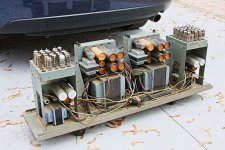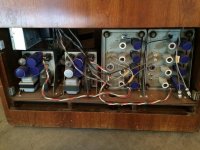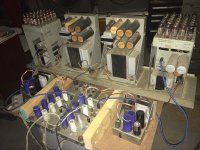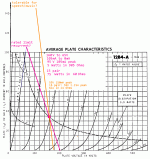Here's a pair of OTL amps that were built in the early 60's by a small company named MP Concert Installations.
The system consists of 8 chassis: pre-amp, pre-amp power supply, power amp, power amp power supply and then X2 for stereo.
I acquired these about two years ago.
The system consists of 8 chassis: pre-amp, pre-amp power supply, power amp, power amp power supply and then X2 for stereo.
I acquired these about two years ago.
Attachments
You would think so, but check out the size of the extension cord that was used to power this bad boy up.
It's a wimpy, little lamp cord - maybe 16ga.
It's a wimpy, little lamp cord - maybe 16ga.
It works, but I really can’t say how well. One of the power amps is not stable and I have not really given these guys a good run.
Those look amazing! 😱 Out of curiosity, what's the recommended load impedance on those bad boys? GL with the re-build!
Those look amazing! 😱 Out of curiosity, what's the recommended load impedance on those bad boys? GL with the re-build!
32 ohm speakers work the best.
I have the original speakers that were paired with the amps.
They are custom built Bozak units (huge).
What are the tubes?
It looks like a truck load of domestic radio pentodes in parallel.
There are (30) 12B4As which have rP of 1030.
1030 / 30 = 34.4. About perfect for 32 ohm speakers.
There are (30) 12B4As which have rP of 1030.
1030 / 30 = 34.4. About perfect for 32 ohm speakers.
With negative feedback you bring much more down than this....
In totem pole you down by four.
With negative feedback you bring much more down than this....
In totem pole you down by four.
So, I really don’t understand this topography. I think we should move this out of the photos gallery forum and maybe I’ll get some education!
Last edited:
Presumably it is based on the Futterman design. I imagine all of those electrolytics now need to be replaced, and there are a lot of them.
It probably sounded pretty good, no one would have gone to this amount of trouble at that time for any other reason.
It probably sounded pretty good, no one would have gone to this amount of trouble at that time for any other reason.
Looks like it says:
MP Engineering Co. Fairfield ? Conn.
I used to live near there.
They don't seem to have read the RCA manual on safe spacing of tubes!
Maybe there is a big fan that blows on each bank of tubes?
Geez, 12B4 are only good for 30 mA each. Someone must have requested this strange design. I can't see marketing that.
MP Engineering Co. Fairfield ? Conn.
I used to live near there.
They don't seem to have read the RCA manual on safe spacing of tubes!
Maybe there is a big fan that blows on each bank of tubes?
Geez, 12B4 are only good for 30 mA each. Someone must have requested this strange design. I can't see marketing that.
...Geez, 12B4 are only good for 30 mA each.....
But 105mA Peak. The most peak in the smallest bottle of any TV-shop tube.
The rp/30 number is a miss. We have to swing the peaks with only 15 tubes. Assuming 105mA it works to 75 Watts in 60 Ohms. Not shabby, if the load can be 60 Ohms.
The rating is for TV V-sweep duty, 105mA peak 60 times a second 6 hours a day all year. Speech/music does not peak very often. If 12B4 are inexpensive, we can hit them harder. Plotting 150mA peak gets near 62W in 24 Ohms. If the speakers turn out to be 30-60r where it matters, the power will be in this 60W-70W range.
The load goes over the Pdiss line. This can be OK. For full-Sine power output, we should compute or measure the plate dissipation. For speech/music, this much over-Pdiss will be fine.
Other plots are possible. 12B4 has positive-grid plots, and we could work-out a class 2 design. But Ig goes up so fast the drive requirements get huge before much is gained.
Attachments
You are right of course, it CAN be done.
But sometimes BIGGER is Better. 6LX6 or 6LW6, 1400 mA peak in the footprint of just 4 of those tubes. Only 2 BIG tubes needed for the whole amplifier.
But then, it probably HAD to be triode. So 30 tubes. I'll bet they ran for 500 hours, cooked some tubes in the center, maybe blew the woofer, cost too much to fix, and was abandoned shortly thereafter. The MP Engineering company name fading into obscurity.
But sometimes BIGGER is Better. 6LX6 or 6LW6, 1400 mA peak in the footprint of just 4 of those tubes. Only 2 BIG tubes needed for the whole amplifier.
But then, it probably HAD to be triode. So 30 tubes. I'll bet they ran for 500 hours, cooked some tubes in the center, maybe blew the woofer, cost too much to fix, and was abandoned shortly thereafter. The MP Engineering company name fading into obscurity.
Last edited:
Although triode outputs provide a certain mystique for sound quality, usually that means loading them at 5X their internal rp to get that. So to justify triode output tubes, this amplifier really needs 5 times as many tubes. Otherwise, you just have a typical high N Fdbk amplifier.
150 12B4 tubes per amplifier! (for a 30 Ohm speaker, 4 times that for an 8 Ohm speaker, 600 tubes per amplifier)
Reliability would be approaching the ENIAC computer, 30 minutes maybe. (OK, a few days) Cost would be out of sight. Power consumption and heat unreal. Repair-ability would mean on-site personnel with test equipment. I don't think this design was really well thought out over-all.
And does it have speaker protection? A 4 or 5 to 1 OT would provide that with minimal affect on sound quality and would bring the tube quantities back down.
A triode emulation scheme could even provide "triode sound" with just 2 big output tubes. 150 Watts output on one chassis.
Well, hind-sight IS wonderful. I don't know what options they had 60 years ago.
150 12B4 tubes per amplifier! (for a 30 Ohm speaker, 4 times that for an 8 Ohm speaker, 600 tubes per amplifier)
Reliability would be approaching the ENIAC computer, 30 minutes maybe. (OK, a few days) Cost would be out of sight. Power consumption and heat unreal. Repair-ability would mean on-site personnel with test equipment. I don't think this design was really well thought out over-all.
And does it have speaker protection? A 4 or 5 to 1 OT would provide that with minimal affect on sound quality and would bring the tube quantities back down.
A triode emulation scheme could even provide "triode sound" with just 2 big output tubes. 150 Watts output on one chassis.
Well, hind-sight IS wonderful. I don't know what options they had 60 years ago.
Last edited:
- Home
- Amplifiers
- Tubes / Valves
- Killer OTLs




